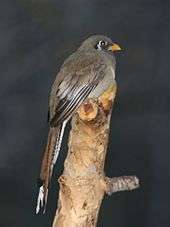Elegant trogon
| Elegant trogon | |
|---|---|
 | |
| Male | |
| Scientific classification | |
| Kingdom: | Animalia |
| Phylum: | Chordata |
| Class: | Aves |
| Order: | Trogoniformes |
| Family: | Trogonidae |
| Genus: | Trogon |
| Species: | T. elegans |
| Binomial name | |
| Trogon elegans Gould, 1834 | |
The elegant trogon (Trogon elegans) (formerly the "coppery-tailed" trogon), is a near passerine bird in the trogon family.[2] Along with the eared quetzal, it is the most poleward-occurring species of trogon in the world, ranging from Guatemala in the south as far north as the upper Gila River in Arizona and New Mexico. The most northerly populations of subspecies ambiguus are partially migratory,[3] and the species is occasionally found as a vagrant in southeasternmost and western Texas.
It is a resident of the lower levels of semi-arid open woodlands and forests. It nests 2–6 metres (7–20 ft) high in an unlined shallow cavity, usually selecting an old woodpecker hole, with a typical clutch of 2–3 eggs.
Description
This species is 28–30 centimetres (11–12 in) long and weighs 60–78 grams (2.1–2.8 oz) (average 68 grams (2.4 oz)). Like other trogons, elegant trogons have distinctive male and female plumages (sexual dimorphism), with soft feathers. Both sexes have a white undertail with fine horizontal black barring. The undertail also has large white tips spaced evenly ending in a black terminal band. Both have a yellow bill, orange-red undertail coverts and lower belly, and a white horizontal breast stripe.[4]

The male elegant trogon has a metallic deep green head, upper breast and back, black face and throat, and red-orange lower breast and belly. He shows grey upperwing coverts. The female has a metallic bronze head, upper breast, back, upper tail and upperwing coverts. She shows a dull white upper belly, and a small white vertical stripe behind the eye.
The usual call is a croaking "co-ah co-ah co-ah". The trogon will also include some chattering notes.
Diet
Elegant trogons feed on insects and fruit, often taken in flight. Their broad bills and weak legs reflect their diet and arboreal habits. Although their flight is fast, they are reluctant to fly any distance. They typically perch upright and motionless.
Subspecies
T. elegans has five recognized subspecies, including the nominate subspecies:[2]
- T. e. ambiguus Gould, 1835
- T. e. canescens Van Rossem, 1934
- T. e. elegans Gould, 1834
- T. e. goldmani Nelson, 1898
- T. e. lubricus J. L. Peters, 1945
References

- ↑ BirdLife International (2012). "Trogon elegans". IUCN Red List of Threatened Species. Version 2013.2. International Union for Conservation of Nature. Retrieved 26 November 2013.
- 1 2 "Trogon elegans Gould, 1834". Integrated Taxonomic Information System. Retrieved 4 May 2011.
- ↑ Elegant Trogon at Encyclopedia of Life
- ↑ Kunzmann, M; Hall, L; Johnson, R (1998). "Elegant Trogon (Trogon elegans)". Birds of North America. Ithica: Cornell Lab of Ornithology;. doi:10.2173/bna.357. Retrieved 6 May 2017.
External links
| Wikimedia Commons has media related to Trogon elegans. |
| Wikispecies has information related to: Trogon elegans |
